I became a Starlink user
Introduction
Service application for Starlink in Japan started in October 2022. Starlink is a service that provides Internet connectivity through a number of satellites orbiting at an altitude of 550 kilometers. I have fast internet at home and work, and cellular tethering on the go, so I don’t think I need Starlink.
But I always wanted to use Starlink someday. Then, I signed up with Starlink because of the half-price hardware sale.
Starlink sign-up
I spent a week wondering if I really needed Starlink. And I wanted to use it again, so I applied on January 25, 2023.
The hardware cost was 73,000 Japanese yen, but it was 36,500 yen for a limited time. The monthly fee is 6,600 yen for the residential plan and 9,900 yen for the RV (recreational vehicle) plan. In the RV plan contract, the use can be temporarily suspended using the smartphone application, and the monthly usage fee will not be charged during the temporary suspension of use. On the other hand, the contract with the RV plan seems to reduce the communication speed when there are many users.
Users can expect high speed, low latency internet in areas marked “High Capacity”, and notably slower speeds during hours of peak usage in areas marked as “Low Capacity” or during events with many collocated users.

The content page changes depending on whether or not you are logged in and the country of the viewing IP address (the content of the page changes dynamically with JavaScript).
Details for each plan are summarized in the Starlink Specifications. According to this description, residential plans and RV plans are classified as fixed service plans and cannot be used while moving. Also, according to the Starlink Terms of Service, the place to use of the RV plan is limited within the same continent of the shipping address, and we need an application of change in the address if we use it for more than 2 months in a different country. Country-specific terms and conditions are summarized in Starlink Legal. I checked the Terms of Use, and I didn’t see any disadvantages to users.
When applying, I was requested to enter address in Japanese. This Japanese address will be displayed on the order screen. In the past, I have had problems with Japanese addresses written in foreign mail, so here I have re-entered the address in English. I was able to place an order by answering the confirmation screen that the address I entered was correct.
Immediately after ordering, I received a confirmation email in Japanese. It said the hardware would be shipped within two weeks, but I actually received the hardware about ten days after placing the order. The parcel was shipped from Long Beach of California. There were no additional charges such as customs fees when I received the parcel.

Setup my Starlink
When I unpacked the package, I saw the antenna part (Starlink Dish).
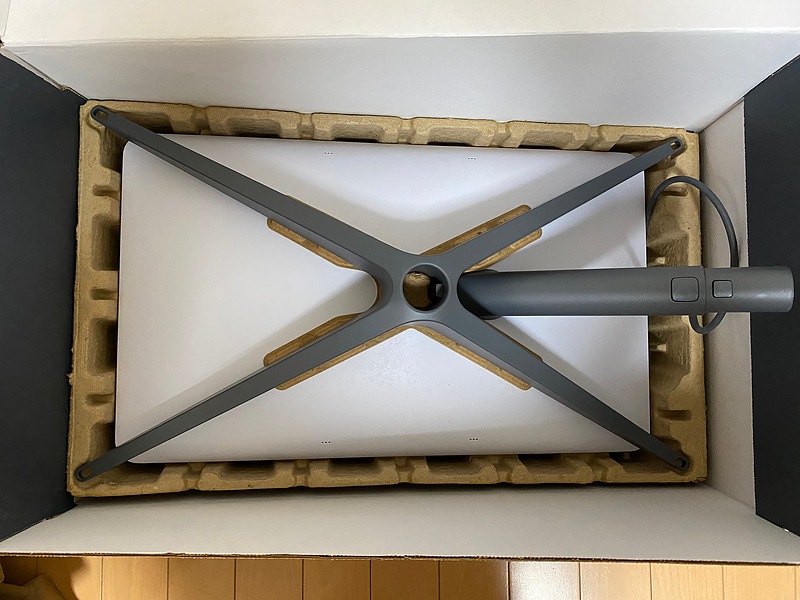
Further down was a Wi-Fi router, a 75-foot antenna cable, and a 6-foot power connection cable (A-type plug with 3-prong ground used in Japan). The router end connectors of these cables had rubber bushings for waterproofing.
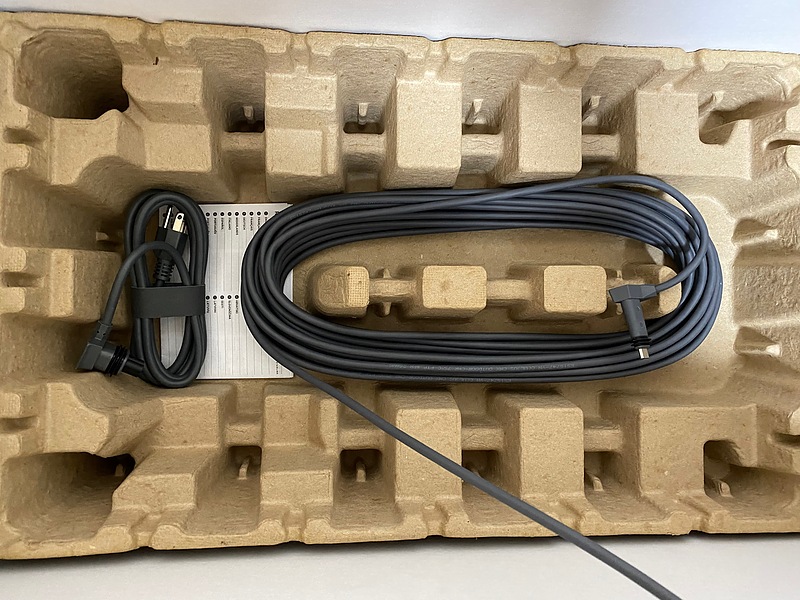
The instructions in the assembly manual are very simple. Simply plug the antenna into the base and connect the two cables to the included Wi-Fi router. This router-side connector is proprietary.
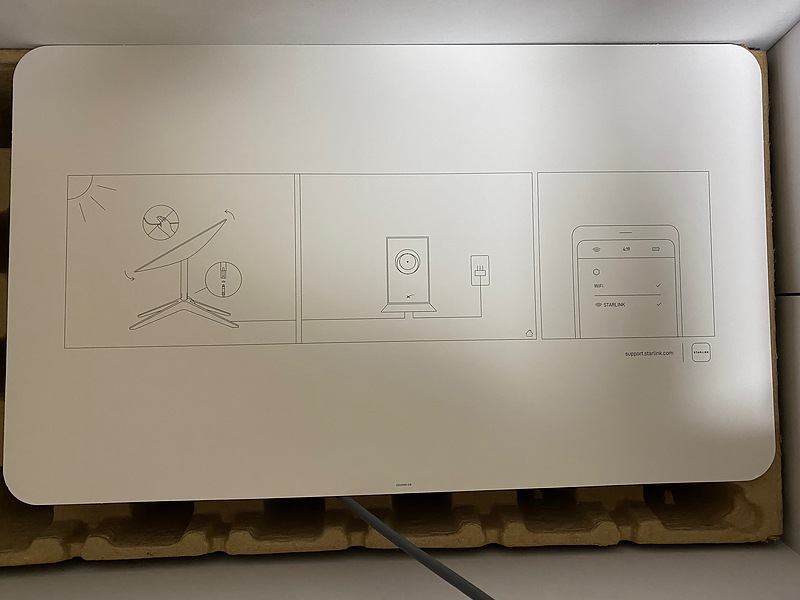
The other manual is also very concise. This Wi-Fi router is a friendly design that can take 100V to 240V 50Hz or 60Hz power supply directly.
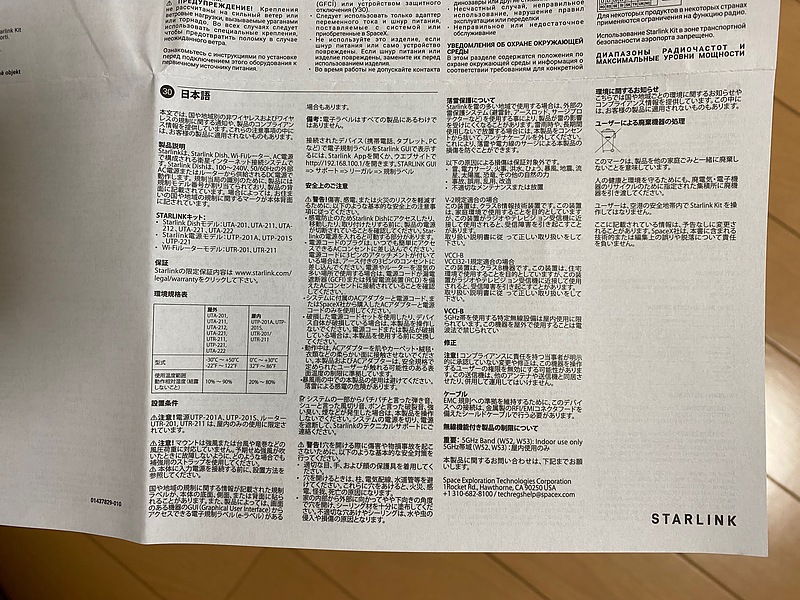
My Starlink Dish’s model number is UTA-212, which says Input PoE (Power over Ethernet) 48 V 2 A for power and IP54 Type 3S for water resistance. On the other hand, the model number of the Wi-Fi router was UTR-211, and there was indication of PoE Output 48 V 2.0 A. This Wi-Fi router also has a waterproof indication of IP54 Type 3S. This Wi-Fi has dual bands of 2.4 GHz band and 5 GHz band, and W52 and W53, which are limited to indoor use in Japan. Therefore, I think this Wi-Fi router is limited to indoor use. There is no wired Ethernet port on the main unit, and an Ethernet adapter is sold separately.
After connecting the power to the Wi-Fi router and one minute has passed, the Starlink Dish antenna will rotate in the zenith direction. At this time, Starlink Dish seems to be discovering Starlink satellites and acquiring ephemeris (satellite orbit). Then, after another 2 minutes, the antenna will automatically rotate to an elevation angle of approximately 60 degrees in the North direction, and satellite Internet will be available.
In order to set up Wi-Fi, I installed an app on my smartphone and connected to a passwordless Wi-Fi access point STINKY (what is STINKY?). The access point name is written as STARLINK in the assembly manual, and the access point name when I set it up later was also STARLINK. After connecting to the Wi-Fi access point, I set my own access point name and password on the smartphone app.
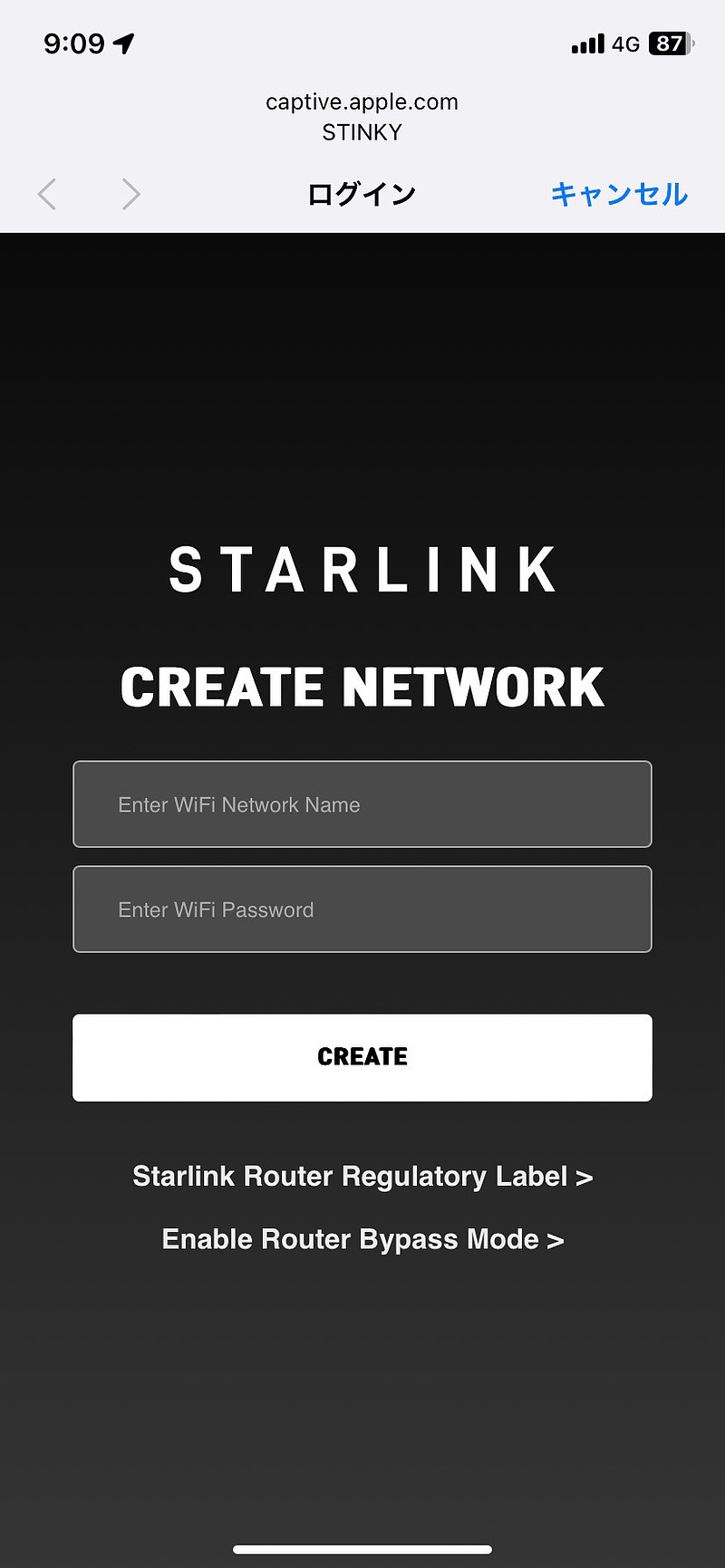
There seems to be a mode that bypasses the router function, but according to the Internet article, this turns off the Wi-Fi connection. On the smartphone app, information such as data usage and contract type were displayed, and there was a button to pause the service.
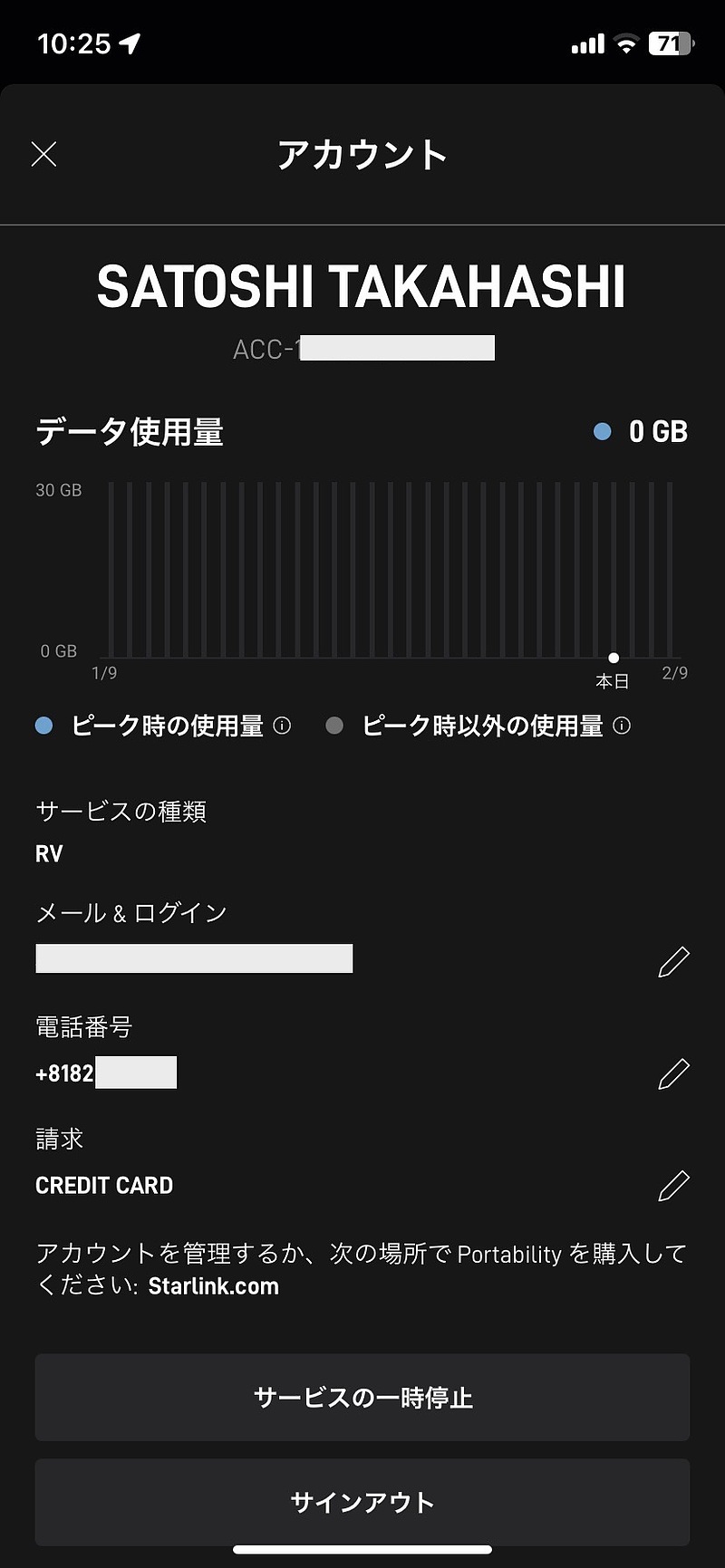
I put the Starlink antenna in my garden. Sky visibility is not very good here, so the connection is frequently interrupted.
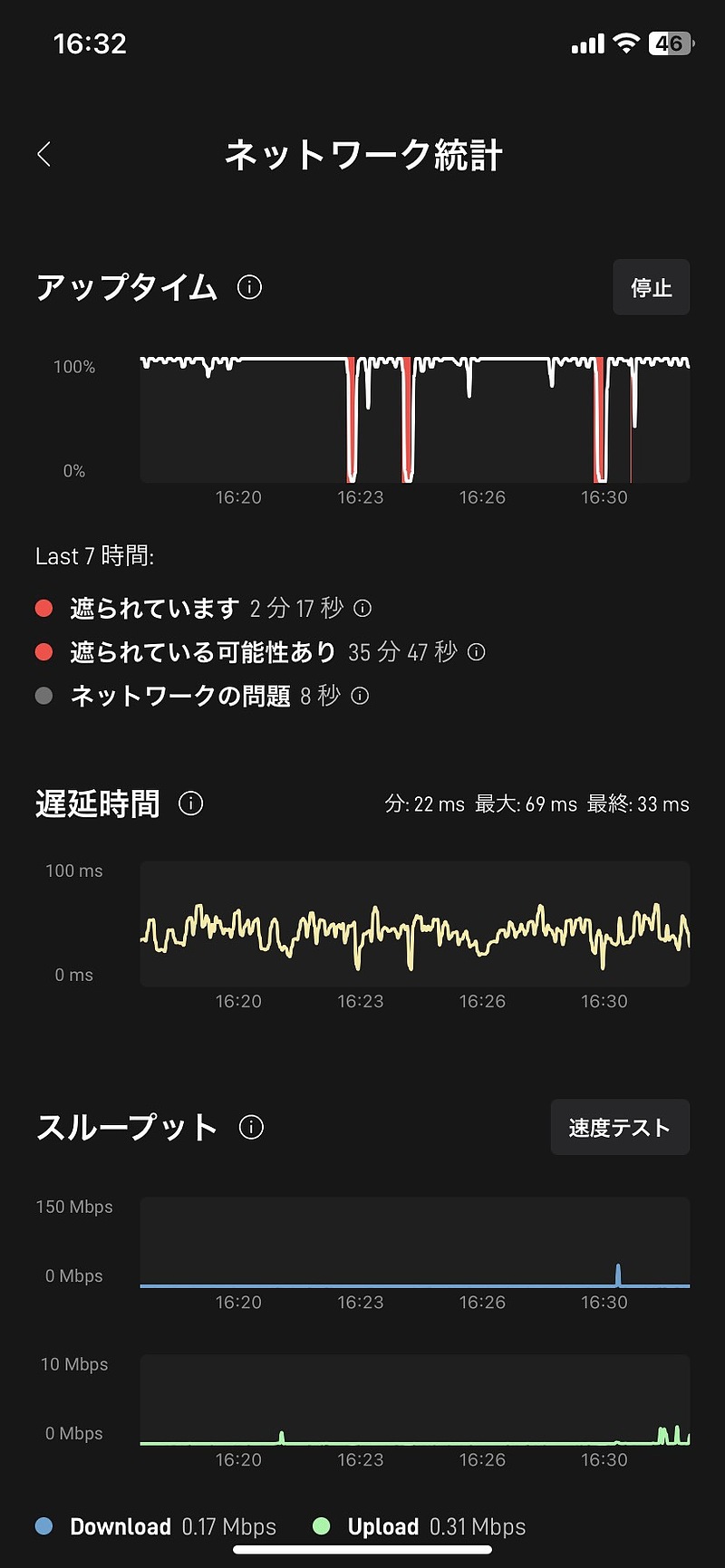
After about 5 hours of continuous use, I can check the status of obstacles in the sky with the smartphone app.
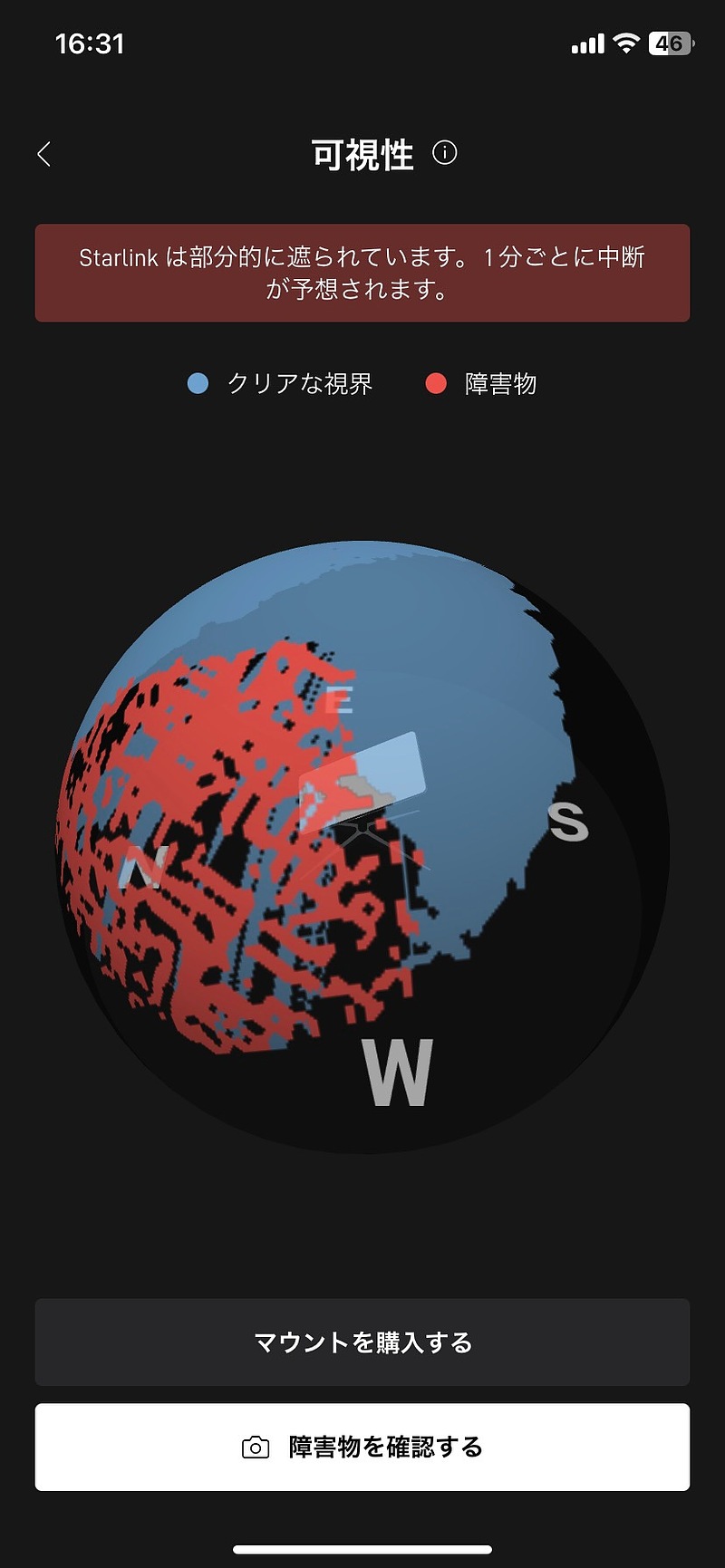
Debug information can also be displayed on the smartphone app. Not much numerical information, but fun to see debugging information.
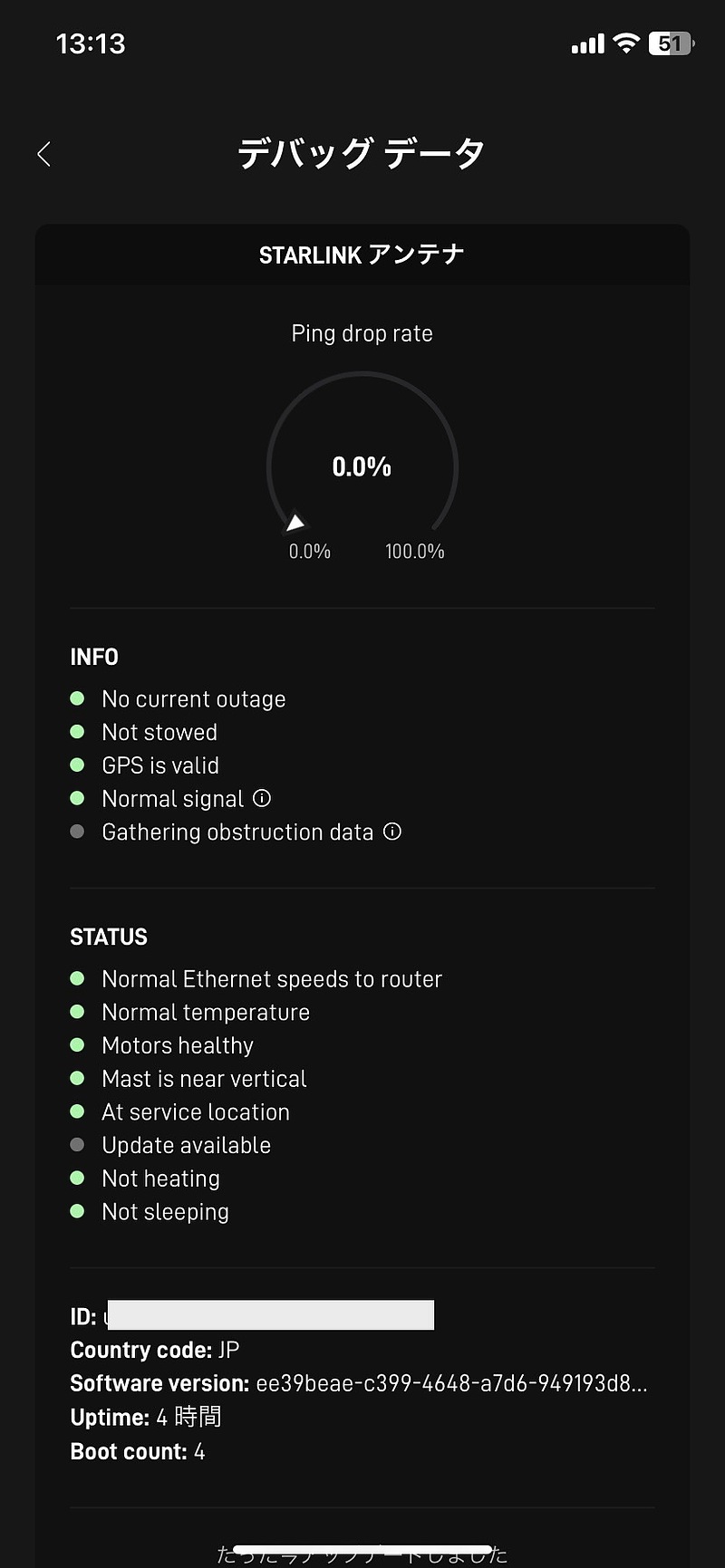
After Wi-Fi connection, we can get a little more device information than this by accessing 192.168.100.1 with a browser.
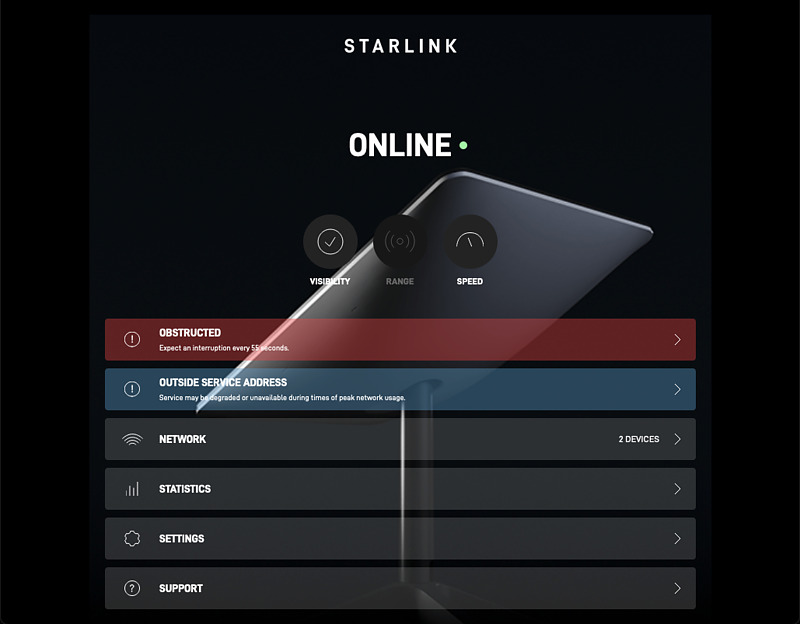
Internet connection
When I connect to this Wi-Fi access point from my computer, it will be assigned an IPv4 address of 192.168.1.0/24 by DHCP (dynamic host configuration protocol). Also, 2406:2d40:xxxx:xxxx::/64 was assigned as an IPv6 address.
The default route and DNS (domain name service) server address are both 192.168.1.1. I tried connecting to this address in my browser (port number 80), but there was no information. Also, port number 9001 is open, but I didn’t know how to use it.
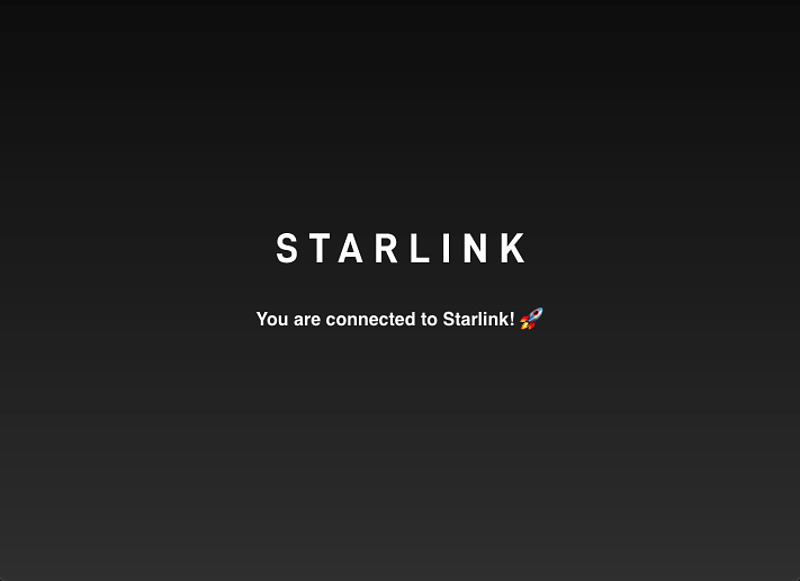
I checked the speed with SPEEDTEST. Download speed was around 84 Mbit/s and upload speed was around 15 Mbit/s. It’s a Wi-Fi connection, so I think it’s something like this.
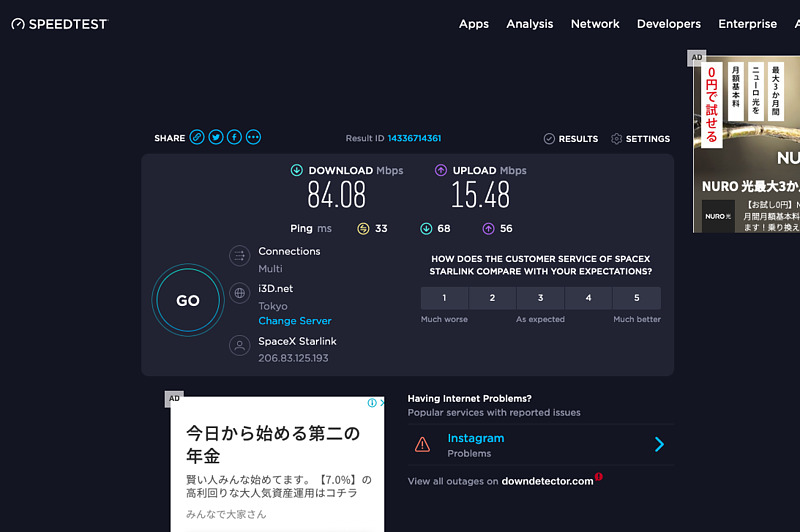
Here are the SPEEDTEST results for the CLI (command line interface) version:
$ speedtest
Speedtest by Ookla
Server: i3D.net - Tokyo (id: 21569)
ISP: Starlink
Idle Latency: 38.90 ms (jitter: 3.20ms, low: 35.41ms, high: 43.69ms)
Download: 86.13 Mbps [=/ ] 8% - latency: 128.69 ms
Download: 85.18 Mbps [=- ] 8% - latency: 128.69 ms
...
Download: 74.24 Mbps [===================-] 97% - latency: 174.75 ms
Download: 74.22 Mbps (data used: 92.5 MB)
174.75 ms (jitter: 56.92ms, low: 39.21ms, high: 631.91ms)
Upload: 14.89 Mbps [\ ] 0% - latency: 174.75 ms
Upload: 29.47 Mbps [===/ ] 19% - latency: 148.58 ms
...
Upload: 30.30 Mbps [====/ ] 22% - latency: 148.58 ms
Upload: 39.48 Mbps (data used: 63.0 MB)
52.59 ms (jitter: 10.20ms, low: 32.79ms, high: 220.47ms)
Packet Loss: 7.0%
Result URL: https://www.speedtest.net/result/
$
The download speed was 74 Mbit/s and the upload speed was 39 Mbit/s.
The IP address displayed at the other end of the Internet connection was 206.83.125.193 (customer.tkyojpn1.pop.starlinkisp.net). All Japanese users seem to share this IP address. It seems that one IP address is shared with 4 users. (Reference: IIJ Engineers Blog Starlink network, IP address, NAT specifications, in Japanese)
Next, I checked the Internet connection path. The first trial is with IPv4.
$ traceroute s-taka.org
traceroute to s-taka.org (172.105.211.235), 64 hops max, 52 byte packets
1 192.168.1.1 (192.168.1.1) 4.813 ms 3.201 ms 2.882 ms
2 100.64.0.1 (100.64.0.1) 48.404 ms 44.229 ms 31.760 ms
3 172.16.248.0 (172.16.248.0) 40.468 ms 25.247 ms 29.423 ms
4 149.19.109.14 (149.19.109.14) 33.290 ms 26.521 ms 34.721 ms
5 as63949.ix.jpix.ad.jp (210.171.225.175) 178.507 ms 184.611 ms 184.932 ms
6 if-7-1.csw2-shg1.linode.com (139.162.64.13) 188.489 ms
if-4-1.csw2-shg1.linode.com (139.162.64.23) 181.089 ms 212.236 ms
7 gw.etakahashi.com (172.105.211.235) 471.283 ms 182.959 ms 191.814 ms
$ traceroute qzss.go.jp
traceroute to qzss.go.jp (133.208.95.242), 64 hops max, 52 byte packets
1 192.168.1.1 (192.168.1.1) 9.971 ms 2.942 ms 2.906 ms
2 100.64.0.1 (100.64.0.1) 32.356 ms 37.507 ms 26.533 ms
3 172.16.248.0 (172.16.248.0) 39.327 ms 38.302 ms 24.710 ms
4 149.19.109.14 (149.19.109.14) 39.394 ms 37.895 ms 26.902 ms
5 as2518-2.ix.jpix.ad.jp (210.171.224.181) 38.550 ms 25.590 ms 38.622 ms
6 133.208.191.35 (133.208.191.35) 38.636 ms
133.208.191.163 (133.208.191.163) 28.550 ms 33.202 ms
7 133.208.190.17 (133.208.190.17) 82.719 ms 36.388 ms 26.785 ms
8 133.205.184.85 (133.205.184.85) 38.479 ms 33.120 ms 52.207 ms
9 * * *
10 133.208.95.242 (133.208.95.242) 72.147 ms 56.474 ms 53.867 ms
$ traceroute www.google.com
traceroute to www.google.com (142.251.42.164), 64 hops max, 52 byte packets
1 192.168.1.1 (192.168.1.1) 3.543 ms 3.076 ms 3.220 ms
2 100.64.0.1 (100.64.0.1) 58.519 ms 33.104 ms 91.018 ms
3 172.16.248.0 (172.16.248.0) 55.721 ms 53.578 ms 56.048 ms
4 149.19.109.14 (149.19.109.14) 38.936 ms 32.181 ms 90.773 ms
5 as15169.ix.jpix.ad.jp (210.171.224.96) 55.898 ms 55.221 ms 37.027 ms
6 108.170.242.129 (108.170.242.129) 78.232 ms 46.524 ms
108.170.242.97 (108.170.242.97) 61.242 ms
7 64.233.175.43 (64.233.175.43) 131.710 ms 133.771 ms 34.285 ms
8 nrt12s46-in-f4.1e100.net (142.251.42.164) 87.326 ms 94.677 ms 51.001 ms
$
It feels really good. Here, the IP address 100.64.0.1 is the IP address assigned to a carrier grade proxy address translation server called CGNAT (carrier grade network address translation), and the IP address 206.83.125.193 is the inner one.
In the process of checking the route, I noticed that the IPv4 route on this site https://s-taka.org/ was unstable and the delay time fluctuated greatly. I’ll check the details later.
Next, I checked the route with IPv6 as well.
$ traceroute6 s-taka.org
traceroute6 to s-taka.org (2400:8902::f03c:91ff:fe22:c8a3) from 2406:2d40:xxxx:xxxx:xxxx:xxxx:xxxx:xxxx, 64 hops max, 12 byte packets
1 customer.tkyojpn1.pop.starlinkisp.net 3.328 ms 3.185 ms 2.801 ms
2 customer.tkyojpn1.pop.starlinkisp.net 44.273 ms 55.021 ms 56.197 ms
3 host.starlinkisp.net 55.837 ms 54.753 ms 59.185 ms
4 2620:134:b004::14 52.875 ms 169.379 ms 132.200 ms
5 2001:de8:8::6:3949:1 110.907 ms 38.838 ms 58.661 ms
6 2400:8902:d::2 53.364 ms
2400:8902:c::2 43.043 ms 42.867 ms
7 gw.etakahashi.com 35.169 ms 44.073 ms 66.638 ms
$ traceroute6 www.google.com
traceroute6 to www.google.com (2404:6800:4004:826::2004) from 2406:2d40:xxxx:xxxx:xxxx:xxxx:xxxx:xxxx, 64 hops max, 12 byte packets
1 customer.tkyojpn1.pop.starlinkisp.net 11.780 ms 7.122 ms 2.594 ms
2 customer.tkyojpn1.pop.starlinkisp.net 31.679 ms 44.692 ms 34.704 ms
3 host.starlinkisp.net 42.369 ms 76.278 ms 44.222 ms
4 2620:134:b004::14 87.500 ms 62.279 ms 45.224 ms
5 2001:de8:8::1:5169:2 80.023 ms 36.158 ms 37.312 ms
6 2001:4860:0:1000::1 40.409 ms *
2001:4860::12:0:b77e 50.863 ms
7 2001:4860:0:1::601d 50.408 ms
2001:4860:0:1::601f 142.571 ms 42.795 ms
8 nrt12s46-in-x04.1e100.net 58.741 ms 55.142 ms 56.086 ms
$
That’s excellent.
Wired Ethernet adapter
I wanted to use Starlink with a more stable wired connection than a Wi-Fi connection, so I ordered an optional Ethernet adapter.
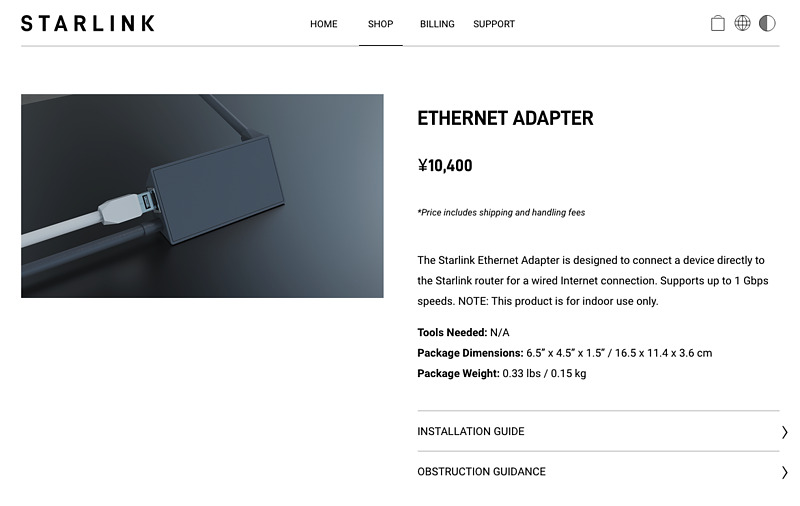
This adapter reportedly sells for US$20 in the US. This Japanese yen price is about four times that price.
However, when I was a company employee, I had a hard time for importing and exporting communication equipments with foreign countries, so I think it can’t be helped that it’s expensive. For a limited time, I was able to get the main hardware for half the price in the US, and the cable seems to be well made, so I’m grateful. I’m looking forward to the arrival of the wired adapter.
Conclusion
I introduced Starlink and I’m happy to introduce it.
People with regular high-speed Internet access may not need Starlink. However, Starlink is a very interesting gadget for engineers. In addition to being able to use high-speed Internet, it is equipped with an antenna base that automatically controls azimuth and elevation angles, an adaptive array antenna that tracks satellites, and control software that automatically acquires satellite orbits and automatically switches satellites (handover). That’s excellent.
About 30 years ago, America’s Motorola launched a satellite communication service called Iridium. It uses 77 low earth orbit satellites and inter-satellite communication, and the element name with atomic number 77 was given as the service name. Later, the number of satellites was reduced to 66, and I was told that it would be difficult as a business, but I respect the engineer who made it that far.
Thirty years have passed since then, and I am deeply moved by the practical use of satellite Internet that is within the reach of the general public. Satellite orbital information (ephemeris) is open to the public. I would like to enjoy Starlink including radio signal observation for a while.
Related article(s):
- au Starlink Direct 24th October 2025
- Starlink Mini 10th April 2025
- Starlink Roam 50GB Plan 4th February 2025
- Starlink bypass mode 30th November 2023
- Starlink connection in an open environment 28th February 2023
- Starlink Ethernet adapter 15th February 2023